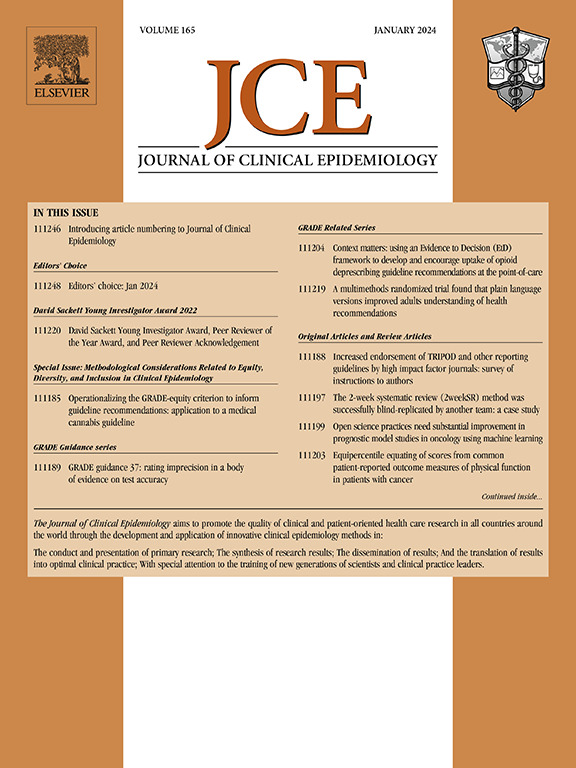Cochrane reviews’ authorship has become more gender-diverse but remains geographically concentrated: a meta-research study
IF 7.3
2区 医学
Q1 HEALTH CARE SCIENCES & SERVICES
引用次数: 0
Abstract
Objectives
The aim of this study was to examine the distribution of country, region, language, and gender diversity in the authorship of Cochrane reviews and compare it to non-Cochrane systematic reviews.
Study Design and Setting
We retrieved all published articles from the Cochrane Library (until November 6, 2023) using a web crawling technique that extracted prespecified data fields, including publication date, review category, and author affiliations. For comparison, non-Cochrane systematic reviews were identified through PubMed using E-utility calls. We determined the country, region of affiliations and gender of the first, corresponding, and last authors for Cochrane reviews; the same fields were determined for first authors only for non-Cochrane reviews due to data availability. Trends in geographical and gender diversity over time were evaluated using logistic regression. Fisher's exact test was used for comparisons. Diversity trends between Cochrane and non-Cochrane reviews were explored through visual presentation, Pearson's product-moment correlation, and the Granger Causality Test.
Results
This comprehensive analysis included 22,681 Cochrane reviews and 224,484 non-Cochrane reviews. Cochrane reviews showed increasing diversity in several areas: representation of first authors from non-English speaking countries rose substantially (from 16.7% in 1996 to 42.8% in 2023), and female first authorship more than tripled (from 15.0% in 1996 to 55.6% in 2023). Representation from lower-and-middle-income countries (LMICs) in Cochrane reviews has declined recently (from a peak of 23.2% in 2012 to 18.4% in 2023). Among Cochrane Review Groups, diversity varied notably, with Sexually Transmitted Infections achieving the highest representation from LMICs (68.1% of first authors). In 2023, non-Cochrane reviews showed higher representation from non-English speaking countries (56.9%) and LMICs (50.8%) compared to Cochrane reviews. The patterns of gender diversity between Cochrane and non-Cochrane reviews showed strong correlations for female first authorship (r = 0.829, P < .001), suggesting parallel evolution over time.
Conclusion
Both Cochrane and non-Cochrane reviews demonstrate important progress in author diversity, particularly in gender representation and inclusion of authors from non-English speaking countries. While non-Cochrane reviews show stronger representation from LMICs, both review sources reflect the evolving landscape of global evidence synthesis.
Cochrane Reviews的作者变得更加性别多样化,但仍保持地域集中:一项元研究。
目的:本研究的目的是检查Cochrane综述作者的国家、地区、语言和性别多样性分布,并将其与非Cochrane系统综述进行比较。研究设计和设置:我们使用网络爬行技术从Cochrane图书馆(截至2023年11月6日)检索了所有已发表的文章,该技术提取了预先指定的数据字段,包括出版日期、综述类别和作者关系。为了比较,非cochrane系统评价是通过PubMed使用E-utility call来确定的。我们确定Cochrane综述的第一作者、通讯作者和最后作者的国家、所属地区和性别;由于数据的可用性,仅在非cochrane综述中为第一作者确定了相同的领域。使用逻辑回归评估了地理和性别多样性随时间的趋势。费雪精确检验用于比较。通过视觉呈现、Pearson积差相关和格兰杰因果检验来探讨Cochrane和非Cochrane综述之间的多样性趋势。结果:这项综合分析包括22,681篇Cochrane综述和224,484篇非Cochrane综述。Cochrane综述显示,几个领域的多样性在增加:来自非英语国家的第一作者显著增加(从1996年的16.7%增加到2023年的42.8%),女性第一作者增加了两倍多(从1996年的15.0%增加到2023年的55.6%)。中低收入国家在Cochrane综述中的代表性最近有所下降(从2012年23.2%的峰值降至2023年的18.4%)。在Cochrane综述组中,多样性差异显著,性传播感染在低收入国家中占比最高(占第一作者的68.1%)。2023年,与Cochrane综述相比,非Cochrane综述显示非英语国家(56.9%)和中低收入国家(50.8%)的代表性更高。Cochrane和非Cochrane综述的性别多样性模式显示,女性第一作者之间存在很强的相关性(r=0.829, p)。结论:Cochrane和非Cochrane综述在作者多样性方面都取得了重要进展,特别是在性别代表性和非英语国家作者的纳入方面。虽然非cochrane综述显示来自中低收入国家的代表性更强,但两种综述来源都反映了全球证据综合的不断发展的格局。
本文章由计算机程序翻译,如有差异,请以英文原文为准。
求助全文
约1分钟内获得全文
求助全文
来源期刊

Journal of Clinical Epidemiology
医学-公共卫生、环境卫生与职业卫生
CiteScore
12.00
自引率
6.90%
发文量
320
审稿时长
44 days
期刊介绍:
The Journal of Clinical Epidemiology strives to enhance the quality of clinical and patient-oriented healthcare research by advancing and applying innovative methods in conducting, presenting, synthesizing, disseminating, and translating research results into optimal clinical practice. Special emphasis is placed on training new generations of scientists and clinical practice leaders.
 求助内容:
求助内容: 应助结果提醒方式:
应助结果提醒方式:


